 Sudoku Cube
Sudoku Cube

 Sudoku Cube
Sudoku Cube

How To Solve A Sudoku Rubik's Cube
(aka Sudoku Cube)
I'm writing this because I tried solving a sudoku cube and was frustrated. I went online and found no useful sites about sudoku cube solutions. There are sites that talk about sudoku cube solutions, but they all seem to skip the actual process of solving the sudoku aspect of the cube. 'I have a sudoku cube, I solved the sudoku part, now here's some stuff about solving Rubik's Cubes.' Or, 'you can use mathematical algorithms to solve the puzzle in the same way as traditional sudoku.' Or they assume at least one of the faces of the cube is straight 1 through 9 (ul = 1, t = 2, ur = 3, etc.; see below).
A sudoku cube is like a Rubik's Cube, but instead of colors on each piece, there are numbers. There appear to be two general varieties of sudoku cube. One type has at least one face with straight 1 through 9. The other type- the type I have- has the numbers randomly distributed on each face.
In regular sudoku you start with a minimum of 17 hints. A sudoku cube doesn't have hints at all in that sense. It does have hints, but they're not of the 'this number definitely goes here, and that number goes there' type. The hints for a sudoku cube are in the orientation of the numbers on each piece. Solving a sudoku cube comes in two parts. First, the sudoku aspect. Figure out which numbers go where. You might want a 4 on the face you're working on, but there are six 4's on the cube. Which one is the right one for this face? The second part is the Rubik's Cube aspect. There are plenty of sites about Rubik's Cube solutions, so i'll leave it to the reader to figure out how to do that part ('and then I solved it!). One bit of warning- If you don't have the patterns for solving each part of a Rubik's Cube memorized very well, it will be hard to keep track of the pieces. On a Rubik's Cube the red and blue pieces are always easy to tell apart, but on a sudoku cube (on mine at least) the numbers all look the same and muddle together. I had to have the patterns down well enough that my hands did the solving without me having to think about it. If this is a problem for you, what you can do is put little pieces of the sticky part of post-it notes on each piece of the cube, then write the first letter of the color and an up arrow on each piece.
Solving my cube is not the same as solving your cube. It is highly unlikely that our cubes will have the same pattern of numbers. The solution for my cube will not give you the solution for your cube, but it will show you how to go about solving your cube.
I used images instead of tables because I don't see how to tell Frontpage to put a different border on the outside of a group of cells than the inner grid.
The current world record for solving a Rubik's Cube is about 7 seconds. I'd like to see a speed cubing competition for sudoku cubes. I doubt i'd be competitive, but it would be nice to see.
The Solution
Notation
ul = upper left
t = top
ur = upper right
l = left
c = center
r = right
ll = lower left
b = bottom
lr = lower right
First thing to do is write down the corner and edge pieces, and draw a blank cube diagram.:

Each corner shows its numbers in clockwise order.
Next, note the orientation for each number. Based on how the number is written on its individual piece, you can tell which kind of piece (ul, t, ur, l, c, r, ll, b, lr) it sits on. The exception, at least for my cube, is '8,' which looks the same flipped horizonally or vertically. '8urll' means it's an 8 that could be in the upper right or lower left corners.
Note: Pieces can be described more than one way for the same piece. Ex: 1ul6ur3ul is the same thing as 6ur3ul1ul and 3ul1ul6ur.
I picked a piece (163, or 1ul6ur3ul) at random to start with, and placed it at a random corner on the diagram.
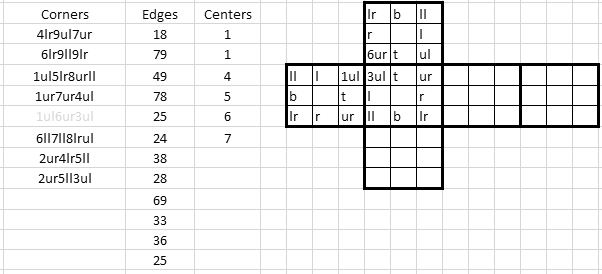
Because I started with a blank diagram, it doesn't matter which piece I started with or which spot on the diagram I started at.
Once I placed 163, that told me the orientation for the rest of the pieces on the three faces 163 touches. That's why I filled in all of the ul, t, ur stuff in the diagram above.
I also grayed out 1ul6ur3ul in the corners column, to show that piece had been used.
I tried putting in question marks for the centers, but it was too distracting, so I took them back out after this step.
Added orientation for the edges. '8lr' means it's an 8 that could be on the left or right side.

Next to the 6 and 3 in 163 in the diagram above are t and t. That means that edge piece has to have a t (or top piece) on each of its two faces.
Looking in the edges column, there's only one piece that has the pattern t, t. That piece is 3t8t.
3t8t is an edge piece, so it could appear as 3 on one face and 8 on the other, or 8 on one face and 3 on the other.
3ul forces 3t8t to appear like this:

3t8t is grayed out to show that that piece has been used.
I also took care of 8urll and 8lrul. On the whole cube there have to be 6 (no more, no less) ll pieces. Looking in the corners column, I see five ll's. 8urll has to be 8ll in order to make the sixth ll. 8lrul has to be 8lr to make the sixth lr.
Below 1ul and 3ul is an edge piece with the pattern t, l. There's only one choice in the edges column with that pattern, so 2l4t has to appear like this:

Looking at the piece next to 3t8t in the diagram above, the orientation is ur, ul, ?. I don't know the orientation of the third face of that piece yet.
In the corners column the only unused piece with a ur followed by a ul is 1ur7ur4ul.

Now that I have 1ur on the next face, that tells me the orientation for the rest of the pieces on that face.
Next (looking at the diagram above), i'll try the side piece below 7ur and 1ur. That side piece has the pattern r, t.
In the edges column the only unused piece with the pattern r, t is 7t9r:

The reason I chose to look at the r, t piece (that became 7t9r) wasn't that I wanted to choose the next piece around the face in the center of the diagram.
To the left of 1ul in the diagram above is an l. Above 6ur is an r. When the cube is folded up, those two will join to form an edge piece with the pattern l, r. Looking in the edges column, there are several unused choices that fit the l, r pattern, so I don't know which edge piece belongs at this spot on the cube.
I kept looking around until I found the edge piece below 7ur and 1ur. I chose that piece because the pattern (r, t) has only one unsued choice in the edges column.
Remember- 7t9r means the same thing as 9r7t.
Looking below 4t and 2l in the diagram above, that corner piece has the orientation pattern ur, ll, ?.
The only unused choice in the corners column is 2ur5ll3ul.
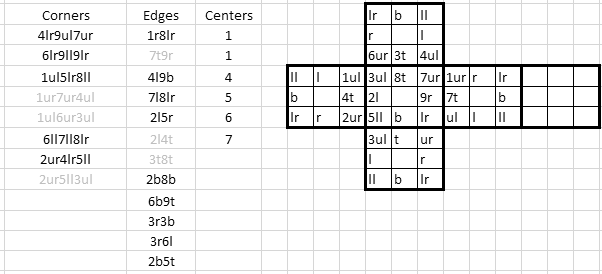
Filling in 3ul allows me to orient the rest of that face now.
Next to 5ll and 3ul is an edge piece with the pattern b, t.
The only choice under the edges column is 6b9t.

Next to 6b and 9t is a corner piece with the pattern ur, lr, ul.
There are two choices that fit the pattern ur, lr, ?, but there's only one choice that fits the pattern ur, lr, ul.
The only choice under the corners column is 4lr9ul7ur.

There's one face that's still empty- no numbers, no orientations. However that face ends up being oriented, it has to have edge pieces t, b, l, and r. For all of those edge pieces, the other sides all have the orientation b. I know the edge pieces for that empty face have to have the patterns tb, bb, lb, and rb. That tells me there are no ll's and no rr's. That means 1r8lr has to be 1r8l and 7l8lr has to be 7l8r.
The diagram shows four places for lr edges. There are four choices in the edges column- 1r8l, 7l8r, 2l5r, and 3r6l.
The only choice... I made a mistake here that I only just now noticed.
The edge piece (r next to 2ur, l next to 3ul). Out of 1r8l, 7l8r, 2l5r, 3r6l, both 2l5r and 3r6l would fit here.
I'm pretty sure that I looked at the diagram and failed to see that the 2 in 2l5r would go next to 3ul (allowable), not 2ur (not allowable). I could lie and say that I realized this (2 possibilites at this spot) when I was working on the cube, and that I decided to try one possibility, then go back and try the other if that one didn't work. I'm pretty sure I just didn't notice my mistake at the time.
I end up with a valid solution at the bottom of this page. I don't know if 2l5r would have ended up in a valid solution or not.

I see in the edges column that there's a piece 3r3b. In the diagram there are four b's without numbers next to them. The faces for three of those b's have 3's on them already, so 3b3r has to go here.
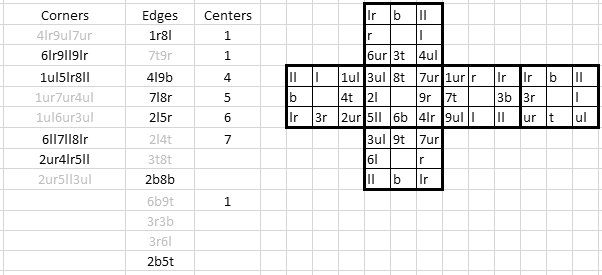
...and now I can fill in the orientation for the last face.
When the diagram folds up into a cube, the t next to 3r (diagonally down to the right) and the b below 9t are part of the same edge piece.
That edge piece has the pattern b, t. There's only one unused edge piece with the pattern b, t.
That edge piece has to be 2b5t.
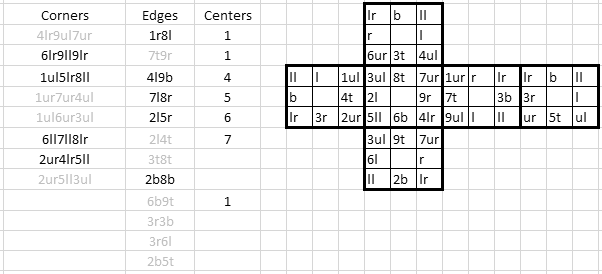
Next is the corner piece above 3b and 3r. The third side of that piece is ll above 4ul.
That corner piece has the pattern lr, lr, ll. There's only one unused piece in the corners column with that pattern.
That corner piece has to be 6lr9ll9lr.
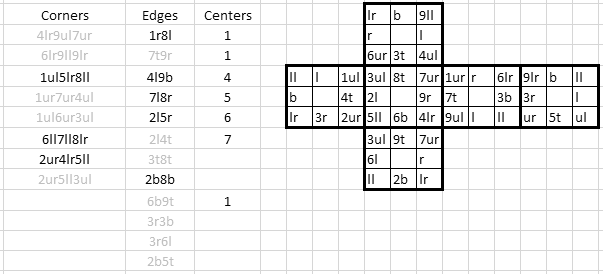
Next is the corner piece below 3b and 3r. The third side of that piece is lr below 7ur.
That corner piece has the pattern lr, ll, ur. There's only one unused piece in the corners column with that pattern.
That corner piece has to be 2ur4lr5ll.

The next piece is a bit tricky to visualize. Looking at the diagram above, lr (to the left of 3r), ll (to the left of 2b), and ul (to the right of 5t) are part of the same corner piece.
That corner piece has the pattern ul, lr, ll. There's only one unused piece in the corners column with that pattern.
That corner piece has to be 1ul5lr8ll.

There's only one piece left in the corners column- 6ll7ll8lr. In the diagram the lr spot to the left of 9ll tells me how to orient the last corner piece.

b to the left of 4t and l to the right of 3r are part of the same edge piece, with the pattern bl. There's only one unused piece in the edges column with that pattern.
That edge piece has to be 4l9b.

b to the left of 9ll and b to the left of 7ll are part of the same edge piece, with the pattern bb. There's only one unused piece in the edges column with that pattern.
That edge piece has to be 2b8b. The presence of 8lr and 2ur tell me which way to orient 2b8b.

There's three lr places left and three edge pieces left. The edge piece comprised of l (below 9ll) and r (to the left of 6lr) can't be 1r8l (due to 8lr) and it can't be 2l5r (due to 2b), so it has to be 7l8r.

The next edge piece is r (below 7ur) and l (to the left of 5ll). It can't be 1r8l (due to 8r), so it has to be 2l5r.

1r8l is the only piece left and there's only one place to put it.
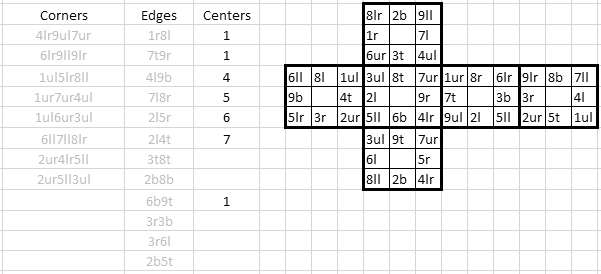
The only thing that's left is to place the centers. Each face of the cube is its own little sudoku puzzle. Since i've filled in all of the edge and corner pieces, there's only one possible solution for each center piece.

Solved.
